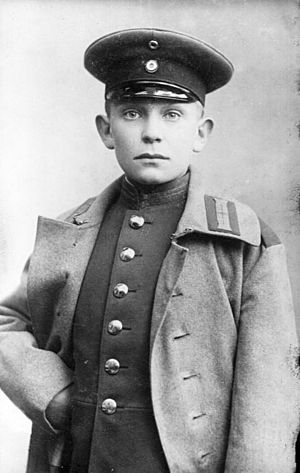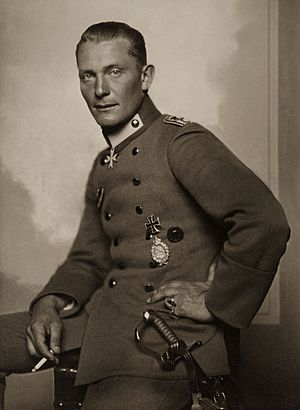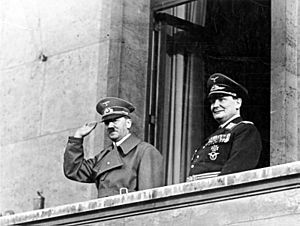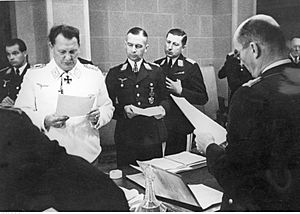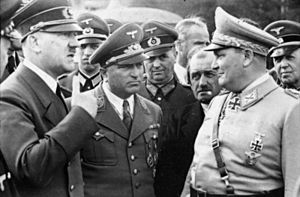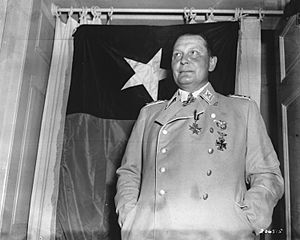Hermann Göring facts for kids
Quick facts for kids
Hermann Göring
|
|
|---|---|
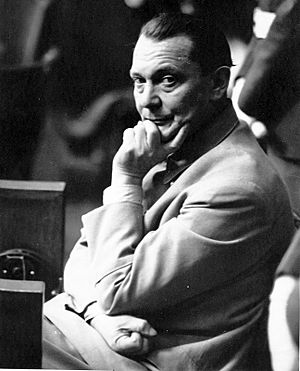
Göring on trial, c. 1946
|
|
| 16th President of the Reichstag | |
| In office 30 August 1932 – 23 April 1945 |
|
| President | Paul von Hindenburg (1932–1934) |
| Führer | Adolf Hitler (1934–1945) |
| Chancellor |
|
| Preceded by | Paul Löbe |
| Succeeded by |
Office abolished
|
| Oberbefehlshaber der Luftwaffe | |
| In office 1 March 1935 – 24 April 1945 |
|
| Führer | Adolf Hitler |
| Preceded by | Office established |
| Succeeded by | Robert Ritter von Greim |
| Reichsstatthalter of Prussia Acting |
|
| In office 25 April 1933 – 23 April 1945 |
|
| Preceded by | Adolf Hitler |
| Succeeded by | Office abolished |
| Ministerpräsident of Prussia | |
| In office 11 April 1933 – 23 April 1945 |
|
| Preceded by | Franz von Papen (Reichskommissar) |
| Succeeded by | Office abolished |
| Additional positions | |
| 1939–1945 | Chair of the Ministerial Council for Reich Defense |
| 1937–1938 | Reichsminister of Economics |
| 1936–1945 | Reich Plenipotentiary of the Four Year Plan |
| 1934–1945 | Reichsminister of Forestry |
| 1933–1945 | Reichsminister of Aviation |
| 1923 | Oberste SA-Führer |
| Personal details | |
| Born |
Hermann Wilhelm Göring
12 January 1893 Rosenheim, Kingdom of Bavaria, German Empire |
| Died | 15 October 1946 (aged 53) Nuremberg Prison, Nuremberg, Allied-occupied Germany |
| Political party | Nazi Party (1922–1945) |
| Spouses | |
| Children | Edda Göring |
| Parents |
|
| Relatives | Albert Göring (brother) |
| Residence | Carinhall |
| Alma mater | University of Munich |
| Occupation |
|
| Cabinet | Hitler Cabinet |
| Signature | |
| Military service | |
| Allegiance | |
| Branch/service |
|
| Years of service |
|
| Rank |
|
| Commands | Jagdgeschwader 1 |
| Battles/wars | |
| Awards |
|
| Criminal conviction | |
| Criminal status | Deceased |
| Conviction(s) | Conspiracy to commit crimes against peace Crimes of aggression War crimes Crimes against humanity |
| Trial | Nuremberg trials |
| Criminal penalty | Death |
Hermann Wilhelm Göring (born January 12, 1893 – died October 15, 1946) was a German politician and military leader. He was one of the most powerful people in the Nazi Party. This party ruled Germany from 1933 to 1945.
Göring was a skilled fighter pilot in World War I. He received a special medal called the Pour le Mérite. After the war, he joined the Nazi Party early on. When Adolf Hitler became Germany's leader in 1933, Göring gained a lot of power. He helped create the Gestapo, which was a secret police force.
Later, Göring became the head of the Luftwaffe, Germany's air force. He was also put in charge of preparing Germany's economy for war. In 1939, Hitler even named him as his possible successor. After France was defeated in 1940, Göring received a special high rank, making him the top soldier in Germany.
As World War II continued, Göring's standing with Hitler and the public went down. This happened because the Luftwaffe couldn't stop Allied bombings of German cities. Göring was later removed from his positions by Hitler. After the war, he was found guilty of serious crimes at the Nuremberg Trials. He was sentenced to death but took his own life before the sentence could be carried out.
Contents
- Hermann Göring's Early Life and Education
- Göring's Role in World War I
- Life After World War I
- Göring Joins the Nazi Party
- The Reichstag Fire
- Göring's Second Marriage
- Rise to Power in Nazi Germany
- World War II and Decline
- Trial and Death
- Göring's Personal Wealth and Art Collection
- Göring's Role in the Holocaust
- Awards and Decorations
- Images for kids
- See also
Hermann Göring's Early Life and Education
Hermann Göring was born on January 12, 1893, in Rosenheim, a town in Bavaria, Germany. His father, Heinrich Ernst Göring, was a former soldier who had been a governor in German South West Africa (now Namibia). Hermann was one of five children.
When Hermann was born, his father was working in Haiti. His mother returned to Germany just to give birth. She left baby Hermann with a friend and did not see him again for three years.
A wealthy family friend, Hermann Epenstein, helped the Göring family. He provided them with homes, including a small castle called Veldenstein. Göring's mother became Epenstein's partner for about 15 years.
From a young age, Göring wanted to be a soldier. He loved playing with toy soldiers. At age 11, he went to a strict boarding school. He didn't like it and pretended to be sick to go home. He enjoyed war games and climbing mountains. At 16, he went to a military academy in Berlin and did very well.
In 1912, Göring joined the Prussian Army. His father died shortly after. When World War I started in August 1914, Göring was stationed near the French border.
Göring's Role in World War I
During the first year of World War I, Göring served in the infantry. He became sick from the damp conditions in the trenches. While he was recovering, a friend convinced him to join the air force.
Göring started as an observer, flying with his friend Bruno Loerzer. They flew missions to scout and bomb enemy positions. For their bravery, they both received the Iron Cross.
After training, Göring became a pilot. He was seriously wounded in a fight in the air and took almost a year to get better. He then joined a fighter squadron and began to win many air battles. He received several medals, including the famous Pour le Mérite in May 1918. He ended the war with 22 confirmed victories.
On July 7, 1918, Göring became the commander of the "Flying Circus." This was a famous fighter wing once led by Manfred von Richthofen, the "Red Baron." However, Göring's proud attitude made him unpopular with his pilots.
Towards the end of the war, Göring refused orders to surrender his squadron's aircraft to the Allies. Many of his pilots crashed their planes on purpose to keep them from the enemy. Like many German soldiers, Göring believed Germany lost the war because of betrayal by politicians, not because of military defeat.
Life After World War I
After the war, Göring continued to work in aviation. He flew planes for fun and briefly worked for an aircraft company. He lived in Denmark and then Sweden, where he worked for a Swedish airline.
In Sweden, Göring met Baroness Carin von Kantzow. She was married with a son, but she and Göring fell in love. They married on February 3, 1922. They first lived in a hunting lodge in the Bavarian Alps.
Göring Joins the Nazi Party
Göring joined the Nazi Party in 1922 after hearing a speech by Adolf Hitler. He was put in charge of the SA, which was the Nazi Party's private army. Carin, Göring's wife, often hosted meetings for top Nazis at their home.
Hitler liked Göring and said he was the only one who organized the SA properly. He turned a disorganized group into a force of 11,000 men.
In November 1923, the Nazis tried to take power in a failed attempt called the Beer Hall Putsch. Göring was wounded during this event. He was smuggled out of Germany for surgery. The authorities in Munich wanted to arrest him.
Göring and Carin moved to Venice, Italy, and struggled financially. In May 1924, Göring met Benito Mussolini, the leader of Italy.
Göring returned to Germany in 1927 after an amnesty. His wife, Carin, who was ill, died in 1931.
The Nazi Party grew in size. In the 1928 elections, Göring was elected to the German parliament, called the Reichstag. He kept this position in all later elections. The Great Depression helped the Nazi Party gain more support. In the July 1932 election, the Nazis became the largest party in the Reichstag. Göring was then elected as the President of the Reichstag. He held this important role until 1945.
The Reichstag Fire
On February 27, 1933, the German parliament building, the Reichstag, caught fire. Göring was one of the first people to arrive at the scene. A Communist radical named Marinus van der Lubbe was arrested and said he started the fire alone. Göring immediately called for a strong response against Communists.
The Nazis used the fire to help their political goals. The next day, a law was passed that removed basic rights and allowed people to be arrested without trial. The Communist Party was shut down, and thousands of its members were arrested. Some historians believe the Nazis themselves were responsible for starting the fire.
At the Nuremberg Trials after the war, a general claimed Göring admitted to starting the fire. Göring denied this story during his own testimony.
Göring's Second Marriage
In the early 1930s, Göring spent a lot of time with Emmy Sonnemann, an actress. They married on April 10, 1935, in Berlin. The wedding was a very big event. Fighter planes flew overhead, and Hitler was Göring's best man. Their daughter, Edda, was born in 1938.

Rise to Power in Nazi Germany
When Hitler became Germany's leader in January 1933, Göring was given several important jobs. He was made a minister without a specific department and later the head of aviation. On April 11, 1933, he became the Prime Minister of Prussia and chief of the Prussian police.
Göring created a special Prussian police force called the Gestapo, which was a secret state police. He later gave control of the Gestapo to Heinrich Himmler.
Hitler was worried that Ernst Röhm, the head of the SA, was planning to take over. Himmler, Reinhard Heydrich, and Göring worked together to use the Gestapo and SS to crush the SA. On June 29, 1934, thousands of SA members protested violently. Hitler ordered the arrest of the SA leaders, and Röhm was killed. At least 85 people were killed in what became known as the Night of the Long Knives. Hitler later said these killings were illegal but claimed it was to stop a plot against the government.
The Treaty of Versailles after World War I had forbidden Germany from having an air force. But in 1935, Germany officially announced the creation of the Luftwaffe (air force), with Göring as its minister.
In September 1936, Hitler put Göring in charge of the Four Year Plan. This plan was to quickly prepare Germany's economy for war. Göring gained control over many government departments. He spent huge amounts of money on rearming Germany.
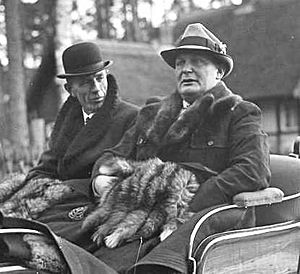
In 1938, Göring was promoted to the rank of Generalfeldmarschall, a very high military rank. He also played a role in Germany taking over Austria in 1938. He threatened invasion if Austria did not agree to join Germany. German troops marched into Austria without resistance.
Göring also got involved in foreign affairs. He discussed Germany's plans for Czechoslovakia with British officials. At a Nazi rally, Göring and others spoke against the Czechs. The Munich Agreement in September 1938 gave Germany control of a part of Czechoslovakia called the Sudetenland. In March 1939, Göring threatened to bomb Prague, forcing the Czechoslovak president to agree to German occupation.
Before the war, Göring was popular with the German public. He was seen as friendly and humorous. He presented himself as someone who cared about Germany's interests. Some in Britain and the United States even thought he could help make peace.
World War II and Decline

Göring and other officers worried Germany wasn't ready for war, but Hitler wanted to move fast. On August 30, 1939, just before World War II began, Hitler made Göring chairman of a new war cabinet. The invasion of Poland started on September 1, 1939. Hitler named Göring as his successor if anything happened to him.
Germany quickly won battles with the help of the Luftwaffe. The Polish Air Force was defeated in a week. German paratroopers captured airfields in Norway and a fort in Belgium. Göring's Luftwaffe was key in the victories in the Netherlands, Belgium, and France in May 1940.
After France fell, Hitler gave Göring the Grand Cross of the Iron Cross for his leadership. In 1940, Hitler promoted Göring to Reichsmarschall, a special rank that made him the highest-ranking soldier in Germany.
Britain declared war on Germany in September 1939. Hitler planned to invade Britain, but first, the Royal Air Force (RAF) had to be defeated. Göring was confident the Luftwaffe could do this. He famously said, "If as much as a single enemy aircraft flies over German soil, my name is Meier!" This statement would later be used against him when the RAF began bombing German cities. The Luftwaffe failed to defeat the RAF in the Battle of Britain, and Hitler postponed the invasion of Britain.
Göring's Power Declines
On June 22, 1941, Nazi Germany invaded the Soviet Union. The Luftwaffe initially destroyed many Soviet aircraft. Hitler and his staff thought the war would be over quickly. However, German forces faced heavy losses and supply problems.

A major turning point in the war was the Battle of Stalingrad in 1942. German forces were surrounded. Göring promised that the Luftwaffe could deliver at least 300 tons of supplies to the trapped soldiers every day. Based on this promise, Hitler ordered them not to retreat. However, the Luftwaffe could not deliver enough supplies. The German army was forced to surrender in February 1943. Only a small number of the captured soldiers survived.
Meanwhile, the US and British air forces grew stronger. They began bombing German cities. Göring's reputation suffered because he failed to protect Germany from these attacks. Hitler started to exclude him from important meetings. Göring spent more time at his homes. On D-Day (June 6, 1944), the Luftwaffe had very few planes to fight the Allied invasion.
The End of the War
As Soviet forces closed in on Berlin in April 1945, Hitler's efforts to defend the city became hopeless. On April 20, Hitler's last birthday, many top Nazis, including Göring, left Berlin. Göring moved to his estate at Obersalzberg. On April 22, Hitler admitted the war was lost and said he would commit suicide. He also said Göring was in a better position to negotiate peace.
Göring believed that since Hitler was staying in Berlin to die, he was no longer able to govern. He sent a telegram to Hitler, asking for permission to take over as Germany's leader. He said if Hitler didn't reply by 10 PM that night, he would assume Hitler had lost his ability to act and would take charge.
Martin Bormann, another Nazi official, intercepted the telegram. He convinced Hitler that Göring was a traitor trying to take power. Hitler then removed Göring from all his positions and ordered his arrest. Göring resigned. He was placed under house arrest.
In his final will, Hitler formally removed Göring as his successor. He appointed Karl Dönitz, the Navy commander, as the new leader. Hitler committed suicide on April 30, 1945.
On May 5, Göring was freed by a German air force unit. He went to the American lines, hoping to surrender to them instead of the Soviets. He was taken into custody on May 6 by the US Army. This likely saved his life, as Bormann had ordered him killed if Berlin fell.
Trial and Death
Göring was taken to a prisoner-of-war camp in Luxembourg. In September, he was moved to Nuremberg, where military trials for top Nazi officials would begin.
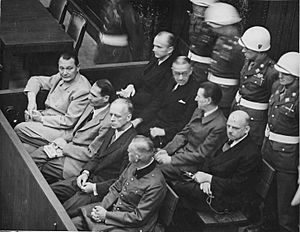
Göring was the second-highest-ranking official tried at Nuremberg. He faced four charges:
- Planning to start a war.
- Starting a war of aggression.
- War crimes, including stealing art and property.
- Crimes against humanity, including the torture and murder of prisoners and civilians, especially Jews.
Göring pleaded "not guilty." The trial lasted 218 days. Göring tried to control the other defendants and was eventually placed in solitary confinement. He told an American psychologist that the court was "stupid" for trying "little fellows" instead of letting him take all the blame.
During the trial, films of concentration camps were shown. Göring claimed the films must have been faked. Witnesses tried to say Göring was a peaceful person. Göring himself said he was loyal to Hitler and knew nothing about the concentration camps, which were controlled by Himmler. He tried to present himself as a peacemaker before the war.
However, prosecutors showed evidence that Göring knew about the persecution of Jews. They showed records of a meeting after Kristallnacht (a violent attack on Jews in 1938). At this meeting, Göring planned to take Jewish property. Evidence also showed he knew about the killing of airmen who escaped from a prison camp and the extermination of Hungarian Jews.
Göring was found guilty on all four charges. He was sentenced to death by hanging. The court said his guilt was "unique in its enormity." Göring asked to be shot as a soldier instead of hanged, but the court refused.
Hours before he was to be hanged, Göring committed suicide using a cyanide capsule. There is speculation about how he got the poison. One theory is that a US Army lieutenant gave it to him. Another theory suggests a former US Army private smuggled it in for him.
Göring's body was displayed and then cremated. His ashes were scattered in the Isar River.
Göring's Personal Wealth and Art Collection
Göring used his power to gain a huge personal fortune. He took Jewish property or bought it for very little money. He also took bribes from businesses for making favorable decisions.
In 1933, Göring was made the head of hunting in Germany, and in 1934, the head of German forests. He made changes to protect endangered animals. He set aside a large forest area as a state park. Here, he built a large hunting lodge called Carinhall, named after his first wife. He moved her body there.
At Carinhall, Göring had a huge art gallery. He displayed artworks that were stolen from private collections and museums across Europe. He worked closely with an organization that looted art and cultural items from Jewish collections. About 26,000 train cars full of stolen art and furniture were sent to Germany from France alone. Göring often visited Paris to choose items for his own homes. His collection was estimated to be worth $200 million.
Göring was known for his fancy and colorful clothing. He had special uniforms made for his many jobs. His Reichsmarschall uniform included a baton covered in jewels. People joked about his large size and his ego. He loved music, especially opera, and hosted many lavish parties. Guests would bring him expensive gifts like gold bars and valuable artwork.
Göring's Role in the Holocaust
While other Nazi leaders were more openly against Jewish people, Göring supported anti-Jewish policies because it was part of the Nazi Party's plan. His deputy, Erhard Milch, even had a Jewish parent.
Göring supported the Nuremberg Laws of 1935, which took away rights from Jewish people. He also started economic rules that harmed Jews. After Kristallnacht in 1938, Göring was angry that German insurance companies would have to pay for the damage to Jewish property. He suggested that Jewish people should be fined one billion marks.
At this meeting, they discussed how to deal with Jewish people and their property. They talked about putting Jews in special areas or encouraging them to leave Germany. Their property would be taken, often with little or no payment. Records of these meetings showed Göring's involvement in the persecution of Jews.
In January 1939, Göring set up an office in Berlin to force Jews to leave Germany. In July 1941, Göring sent a memo to Reinhard Heydrich, ordering him to plan the "Final Solution" to the "Jewish Question." This plan was the systematic murder of Jewish people. By the time this letter was written, many Jews had already been killed. At the Wannsee Conference six months later, it was formally announced that the genocide of Jews was official Nazi policy. Göring did not attend this conference, but he was at other meetings where the number of people killed was discussed.
Göring also directed operations in the Białowieża Forest between 1942 and 1944. These operations led to the murder of thousands of Jewish and Polish civilians.
At the Nuremberg trial, Göring claimed he would never have supported the anti-Jewish actions if he had known what would happen. He said he only thought they would remove Jews from important jobs in business and government.
Awards and Decorations
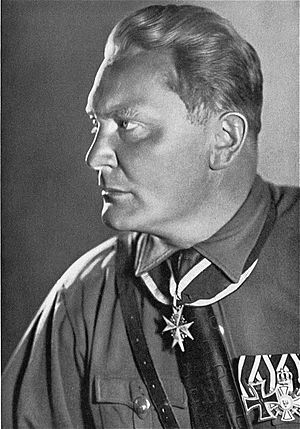
German Awards
- Iron Cross (2nd Class in 1914, 1st Class in 1915)
- Pour le Mérite (1918)
- Blood Order (1923)
- Clasp to the Iron Cross (2nd and 1st Class in 1939)
- Knight's Cross of the Iron Cross (1939)
- Grand Cross of the Iron Cross (1940) – the only person to receive this during World War II.
- Order from the Grand Duke of Baden Orden vom Zähringer Löwen (de) Knights Cross 2nd Class with Swords
- Golden Party Badge
- Knights Cross with Swords of the House Order of Hohenzollern
- Knights Cross of the Military Karl-Friedrich Merit Order
- Danzig Cross, 1st and 2nd class
Foreign Awards
- Knight of the Order of Saints Cyril and Methodius (Bulgaria)
- Grand Cross of the Order of the Dannebrog, with Breast Star in Diamonds (Denmark) (1938)
- Grand Cross of the Order of the White Rose of Finland (1935)
- Grand Cross with Collar of the Order of the White Rose of Finland (1941)
- Grand Cross with Swords of the Order of the Cross of Liberty (Finland) (1942)
- Grand Cross of the Order of St Stephen (Hungary)
- Knight of the Supreme Order of the Most Holy Annunciation (Italy) (1940)
- Commander Grand Cross of the Order of the Sword, with Collar (Sweden) (1939)
- Grand Cordon of the Order of the Rising Sun, with Paulownia Flowers (Japan) (1943)
Images for kids
See also
 In Spanish: Hermann Göring para niños
In Spanish: Hermann Göring para niños
- Aerial victory standards of World War I
- Air warfare of World War II
- Fallschirm-Panzer Division 1 Hermann Göring
- Glossary of Nazi Germany
- Glossary of German military terms
- Göring's Green Folder
- List of Nazi Party leaders and officials


